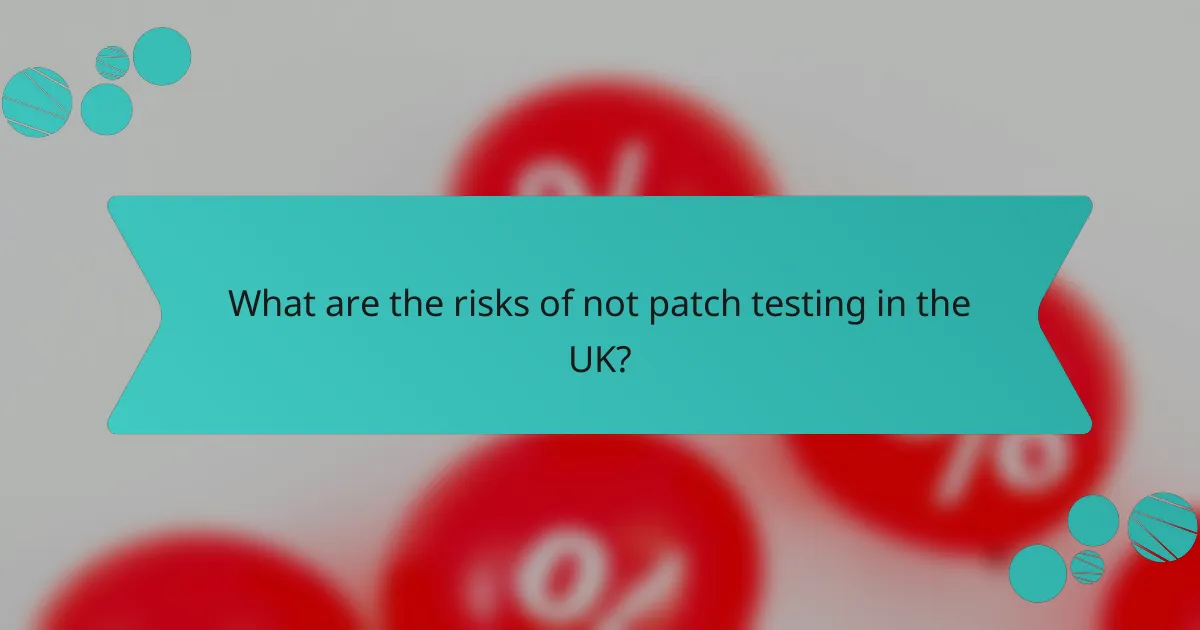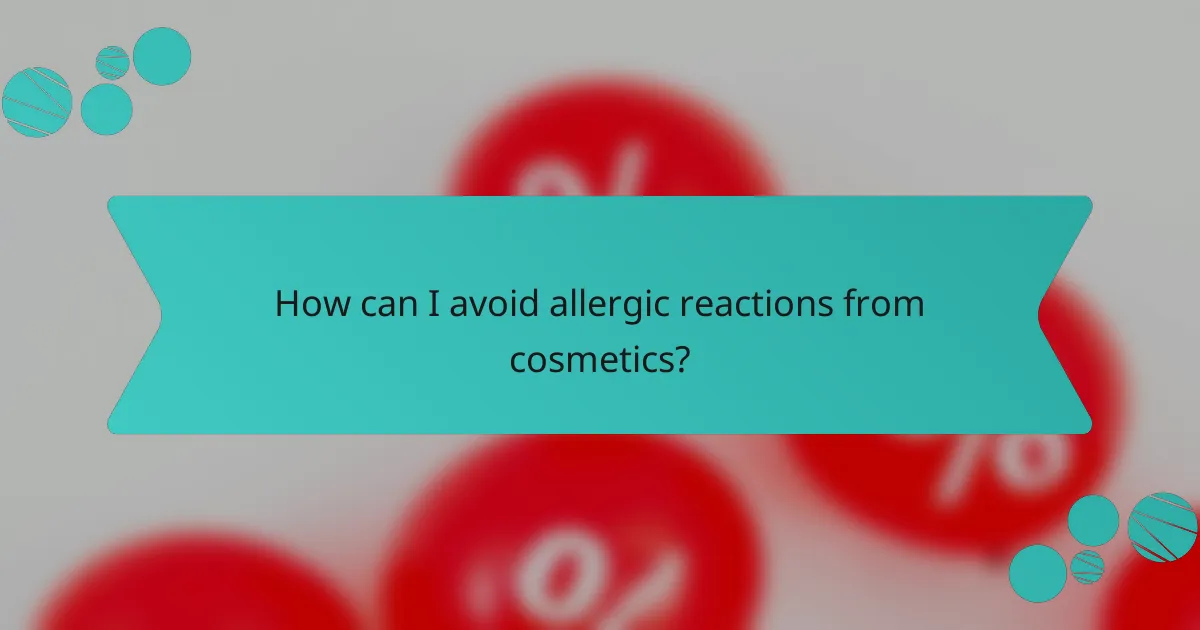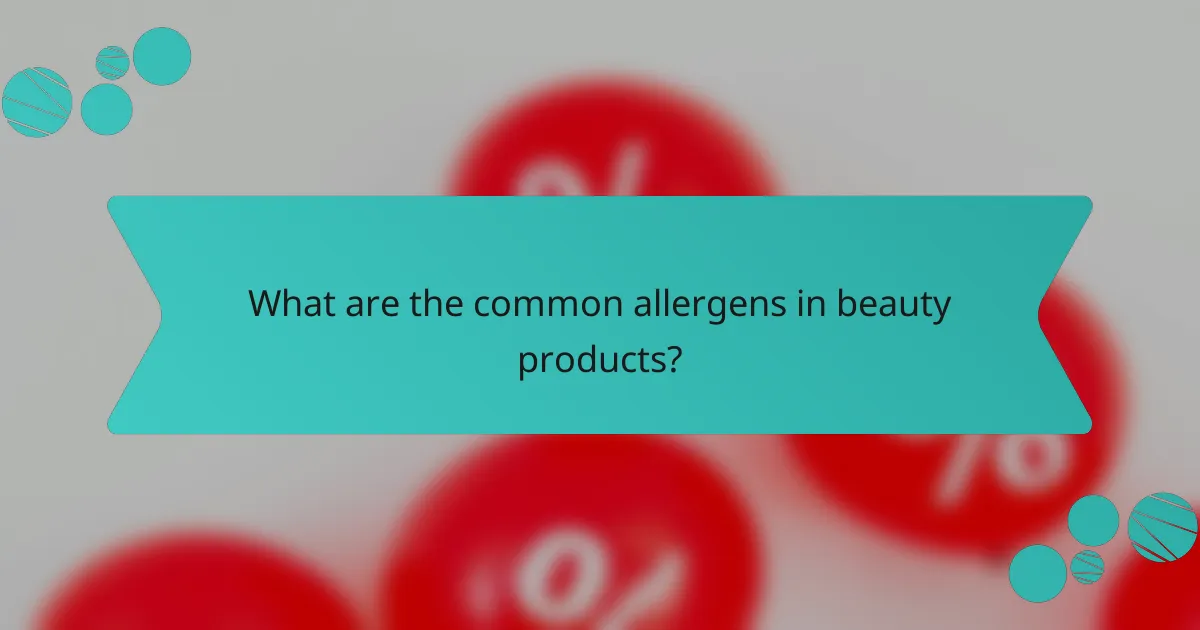Failing to patch test new cosmetic products can result in allergic reactions and skin irritation, leading to unnecessary waste and discomfort. By taking the simple step of performing a patch test, individuals can identify potential irritants and significantly reduce the risk of adverse skin responses. Adhering to best practices for patch testing ensures that products are safe for use, promoting healthier skin and minimizing product waste.

What are the risks of not patch testing in the UK?
Failing to patch test can lead to allergic reactions, skin irritation, and unnecessary product waste. Without this precaution, individuals may experience adverse skin responses that could have been avoided.
Allergic reactions
Allergic reactions to skincare or cosmetic products can occur when the skin is exposed to new ingredients without prior testing. Symptoms may include redness, swelling, and itching, which can vary in severity. In the UK, common allergens include fragrances, preservatives, and certain dyes.
To minimize the risk of allergic reactions, always conduct a patch test on a small area of skin before using a new product extensively. If any irritation occurs within 24 to 48 hours, it’s best to avoid using that product.
Skin irritation
Skin irritation is another significant risk associated with not patch testing. Ingredients that may seem harmless can cause reactions, especially for sensitive skin types. Symptoms can range from mild redness to severe rashes.
To avoid irritation, consider factors such as skin type and existing conditions. Products labeled as “hypoallergenic” may still cause irritation, so patch testing remains essential for everyone.
Product waste
Not patch testing can lead to significant product waste, as many individuals may discard products that cause adverse reactions. This not only results in financial loss but also contributes to environmental waste.
To reduce waste, always perform a patch test before committing to a new product. This simple step can save money and minimize the environmental impact of discarded items.

How can I avoid allergic reactions from cosmetics?
To avoid allergic reactions from cosmetics, always perform patch tests before using new products. This simple step can help identify potential irritants and minimize the risk of adverse reactions.
Conduct patch tests
Patch testing involves applying a small amount of the cosmetic product to a discreet area of skin, typically on the inner arm or behind the ear. Leave it on for 24 to 48 hours and observe for any signs of irritation, redness, or swelling. If no reaction occurs, the product is likely safe for broader use.
It’s advisable to conduct patch tests for each new product, especially if you have sensitive skin or a history of allergies. Even products labeled as “gentle” or “for sensitive skin” can cause reactions in some individuals.
Choose hypoallergenic products
Hypoallergenic products are formulated to minimize the risk of allergic reactions. They typically contain fewer allergens and irritants, making them a safer choice for sensitive skin. Look for products that are fragrance-free and free from common irritants like parabens and sulfates.
While hypoallergenic does not guarantee that a product will not cause a reaction, it can significantly reduce the likelihood. Always check ingredient lists and consider consulting with a dermatologist if you have specific concerns about allergies.

What are the best practices for patch testing?
Best practices for patch testing involve following specific guidelines to minimize the risk of allergic reactions and irritation. Proper patch testing can help ensure that products are safe for use on your skin, reducing waste and potential discomfort.
Follow the 48-hour rule
Adhering to the 48-hour rule is crucial for effective patch testing. This means applying the product to a small area of skin and leaving it undisturbed for at least two days. This duration allows enough time for any potential reactions to manifest, providing a clearer indication of the product’s safety.
During this period, avoid washing the area or applying other products, as this could interfere with the test results. If irritation or an allergic reaction occurs, it’s best to remove the product immediately and consult a healthcare professional if necessary.
Use a small area of skin
When patch testing, select a small, discreet area of skin, such as the inside of your wrist or behind your ear. This minimizes the risk of widespread irritation and allows you to monitor the reaction closely without affecting larger skin areas.
Using a small area also helps in identifying specific sensitivities to ingredients without wasting the product. If the test area shows no adverse reactions after 48 hours, it is generally safe to proceed with using the product on larger areas of your skin.

What should I do if I experience irritation?
If you experience irritation after using a product, stop using it immediately to prevent further discomfort. Assess the severity of the reaction and consider seeking professional advice if necessary.
Stop using the product
Cease using the product that caused the irritation right away. Continuing to apply it can exacerbate the reaction and lead to more severe symptoms. Discontinue use even if the irritation seems mild.
Check the product’s ingredients for any known allergens or irritants that may have triggered your reaction. This can help you avoid similar products in the future.
Consult a dermatologist
If irritation persists or worsens, consult a dermatologist for a professional evaluation. They can provide tailored advice and may recommend treatments to alleviate symptoms.
During your appointment, be prepared to discuss your skincare routine, any allergies, and the specific product that caused the irritation. This information will help the dermatologist identify potential causes and recommend suitable alternatives.

How do patch tests vary by product type?
Patch tests differ by product type in their application and the potential for allergic reactions. Understanding these variations helps minimize irritation risks and product waste.
Skincare products
When testing skincare products, a small amount is applied to a discreet area of skin, typically on the inner forearm. This method allows for observation of any reactions over 24 to 48 hours. Common irritants in skincare include fragrances, preservatives, and active ingredients like retinol.
To conduct a patch test, cleanse the area first, apply the product, and cover it with a bandage. After the testing period, check for redness, swelling, or itching. If any adverse reactions occur, discontinue use immediately to prevent further irritation.
Hair dyes
Patch testing hair dyes is crucial due to the strong chemicals involved, such as ammonia and peroxide. Apply a small amount of the mixed dye behind the ear or on the inner elbow and leave it for 48 hours. This helps identify any allergic reactions before full application.
Always follow the manufacturer’s instructions for patch testing. If you experience itching, burning, or swelling during the test, do not use the product. Hair dye reactions can be severe, so err on the side of caution to avoid potential complications.

What are the common allergens in beauty products?
Common allergens in beauty products include ingredients that can trigger allergic reactions or skin irritation. These allergens often lead to discomfort, rashes, or other adverse effects, making it essential to identify and avoid them when possible.
Fragrances
Fragrances are one of the most prevalent allergens found in beauty products. They can be derived from natural or synthetic sources and are often added to enhance the scent of lotions, shampoos, and cosmetics. However, many individuals may experience allergic reactions or skin irritation due to these compounds.
To minimize the risk of irritation, consider using fragrance-free products or those labeled as hypoallergenic. Always check ingredient lists, as terms like “parfum” or “aroma” can indicate the presence of fragrances.
Preservatives
Preservatives are used in beauty products to prevent microbial growth and extend shelf life. Common preservatives, such as parabens and formaldehyde-releasing agents, can cause allergic reactions in sensitive individuals. While they are necessary for product safety, they can also lead to skin irritation.
When selecting products, look for those that use alternative preservatives or are labeled as preservative-free. Conducting a patch test before using a new product can help identify any potential reactions to these ingredients.
